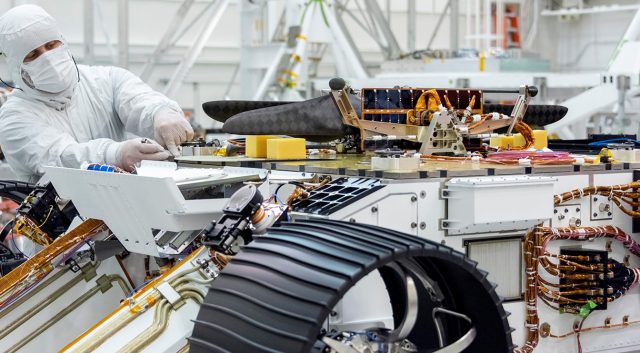
NASA is still busy integrating the systems that will let the new Mars 2020 rover explore the red planet, but engineers took time to hook up the rover’s sole passenger this week: the Mars Helicopter. The small experimental aircraft is now installed on the belly of the rover, ready to ride the larger robot down to the surface of Mars. Once there, it will, hopefully, make history as the first-ever aircraft to fly on another planet.
NASA began developing the Mars Helicopter Scout concept several years before rover assembly. After testing showed the design was viable, the agency secured $23 million in funding to make it a reality in time for the summer 2020 rover launch. The Mars Helicopter won’t include any scientific instruments because it’s considered a technology demonstration. NASA doesn’t want to trust any vital tasks to the first aircraft to ever fly on Mars. The solar-powered helicopter will have a camera, which could help the rover navigate around rough terrain and obstacles.
To install the helicopter and its deployment system, engineers at NASA JPL had to flip Mars 2020 on its back. The rover is upside-down in the image above, giving the team access to the bottom surface for helicopter mounting. The rover will drop the Mars Helicopter Scout on the surface after its landing at Jezero Crater in 2021. In the meantime, a cover shield will remain in place to protect the helicopter during launch and landing.
NASA has tested the helicopter in a vacuum chamber here on Earth. The chamber dropped to Mars-like atmospheric pressure, which makes it harder to generate lift. However, the Mars Helicopter Scout is just 4 pounds (1.8 kg). While we can’t change gravity, NASA used a “gravity offload system” that tugs upward on the rover to make it behave as if it were lighter. The helicopter successfully hovered in the chamber, so the team thinks it will be able to fly on Mars.
After deployment on the surface, the Mars Helicopter Scout will fly up to five times over a month. Although, NASA has a habit of designing robots that far outlive their original mission parameters. The helicopter might take more flights than anyone is expecting. A successful test of the helicopter on Mars could mean much more ambitious flying robots will head to the red planet in the future. A flying probe could reach perilous cliffs, deep craters, and other locations inaccessible to a wheeled rover.
